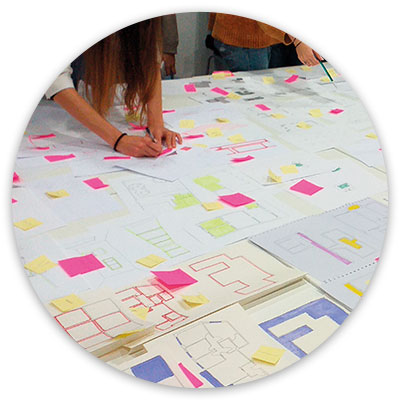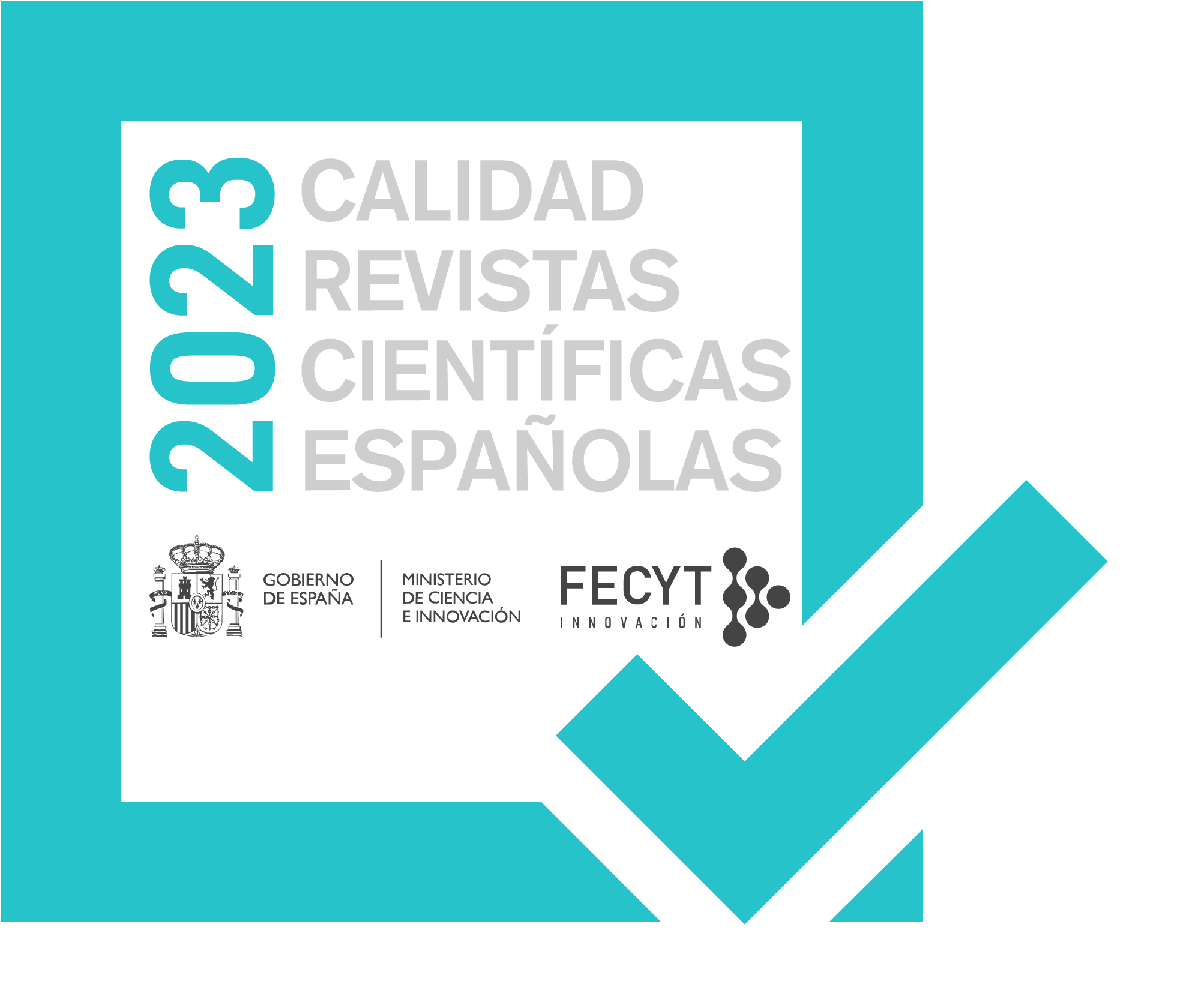SpanishDynamics-aktion II
Proposal of pedagogical dynamics, useful in the design project workshop and beyond
DOI:
https://doi.org/10.24310/Idiseno.2022.v17i.14549Keywords:
dynamics, pedagogy, project workshop, design, evaluationAbstract
This paper analyses and evaluates a series of pedagogical dynamics used in the Interior Projects Design Studio (Degree in Interior Design).
Each dynamic is artistically designed, almost like an action, to create a ‘learning event’ and teach the content of Design Studio through experience.
These dynamics are inspiring, to such an extent that they can be transferred to any discipline. However, this article includes a specific theoretical support: a discussion and a comparative contrast with different models of the pedagogical method of the project Design Studio.
This paper constitutes the second part of a previous paper: Dynamics-aktion[1]. Thus, it continues describing dynamics that are not included in the previous paper, while it moves towards an evaluative conclusion of the content of the two papers. At the same time, both papers complement a previous article which described an approach of a whole course of Interior Design Projects: #eindakoa# (lo que hemos hecho) Un MÉTODO pedagógico del MÉTODO de Proyectos de Diseño de Interior.[2]
Downloads
Metrics
Publication Facts
Reviewer profiles N/A
Author statements
Indexed in
-
—
- Academic society
- N/A
- Publisher
- Universidad de Málaga
References
Besa, E. (2007). «Miguel Fisac, una metodología proyectual». Espacio, tiempo, forma. Serie VII, Historia del arte, 20-21, 391-415. DOI: https://doi.org/10.5944/etfvii.20-21.2007.1478
Besa, E. (2015a). Arquitecto, obra y método. Análisis comparado de diferentes estrategias metodológicas singulares de la creación arquitectónica contemporánea. Tesis Doctoral, ETSAM UPM. OAI: http://oa.upm.es/38053/
Besa, E. (Agosto 23, 2015b). «Vitoria in-between Gasteiz». El Correo español-el Pueblo vasco, 33.
Besa, E. (2019). «#eindakoa# (lo que hemos hecho) Un MÉTODO pedagógico del MÉTODO de Proyectos de Diseño de Interior». EARI, Educación Artística Revista de Investigación, 10, 33-63. DOI: https://doi.org/10.7203/eari.10.13763 (Partially published in English: Besa, E. (March 24-25, 2022). #eindakoa (what we’ve done). A pedagogical method of Interior Design Studio method. Architectural Episodes 02 Symposium, Istanbul, Turkey. Accessible at the Researchgate.net account of the author.)
Besa, E. (2021a). Arquitecto, obra y método: Kazuyo Sejima, Frank O. Gehry, Álvaro Siza, Rem Koolhaas, Peter Zumthor. Diseño Editorial.
Besa, E. (2021b). «Dynamics-aktion. Propuesta de dinámicas pedagógicas, útiles en el Taller de Proyectos de diseño y más allá». EARI, Educación Artística Revista de Investigación, 12, 23-42. DOI: https://doi.org/10.7203/eari.12.17633. (Published in English: Besa, E. (2022). «Dynamics-Aktion- Pedagogical dinamics proporsal, useful for design studio teaching and beyond». ShodhKosh: Journal of Visual and Performing Arts, 3(1), 349-377. DOI: https://doi.org/10.29121/shodhkosh.v3.i1.2022.118 )
Bugarin Kamour, O. (2021). «Aprendiendo de Ekalavya». Publicado en: Millán, P.M. (ed.) (2021). DEambulatorio ARchitectonica II. Diseño Editorial.
Blair, B. & Blythman, M. & Orr, S. (2007). Critiquing the Crit. Project Report. Higher Education Academy. URI: https://ualresearchonline.arts.ac.uk/id/eprint/7385
Bohigas, O. (1972). Proceso y erótica del diseño. La Gaya Ciencia.
Brindley, T. & Doidge, C. & Willmott, R. (2000). Introducing alternative formats for the project review, in: Nicol, D. & Pilling, S. (Eds.). (2000). Changing Architectural Education. Towards a New Professionalism. Spon Press, 91-97.
Brunon, J. (1971). «Group Dynamics and Visual Thinking». Journal of Architectural Education, 25 (3), 53-55. DOI: https://doi.org/10.2307/1423837
Ciravo?lu, A. (2014). «Notes on architectural education: An experimental approach to design studio. Procedia» - Social and Behavioral Sciences, 152, 7-12. DOI: https://doi.org/10.1016/j.sbspro.2014.09.146
Cropley, A. J., & Urban, K. K. (2000). «Programs and Strategies for Nurturing Creativity», in: Heller, K. A., Mönks, F. J., Sternberg, R. J. & Subotnik, R. F. (Eds). International Handbook of Giftedness and Talent, Pergamon, 485-498. DOI: https://doi.org/10.1016/B978-008043796-5/50034-6
Cropley, D. & Cropley, A. J. (2010). «Functional creativity: ‘Products’ and the generation of effective novelty», in: J. C. Kaufman & R. J. Sternberg (Eds.). Cambridge Handbook of Creativity, New York: Cambridge University Press, 301-317.
Curry, T. M. (2017). Form Follows Feeling: The Acquisition of Design Expertise and the Function of Aesthesis in the Design Process. A + BE | Architecture and the Built Environment. DOI: https://doi.org/10.7480/abe.2017.6.1802
Curry, T. M. (2014). «A theoretical basis for recommending the use of design methodologies as teaching strategies in the design studio». Design Studies, 35(6), 632-646 DOI: https://doi.org/10.1016/j.destud.2014.04.003
De Bono, E. (1986). Six Thinking Hats. England: Viking. (Trad. Española: PANDOLFO, M. (1988). Seis sombreros para pensar. Ediciones Juan Granica).
Dutton, T.A. (1987). «Design and Studio Pedagogy». Journal of Architectural Education, 41(1), 16-25. DOI: https://doi.org/10.1080/10464883.1987.10758461
Español, J. (2001). El orden frágil de la arquitectura. Arquia/tesis, Fundación Arquia.
Frederickson, M.P. (1990). «Design juries: A study in lines of communication». Journal of Architectural Education, 43(2), 22-27. DOI: https://doi.org/10.1080/10464883.1990.10758556
Gallagher, S. (1992). Hermeneutis and Education. State University of New York Press.
Glasser, D. (2000). «Reflections on Architectural Education». Journal of Architectural Education, 53(4), 250-252. DOI: https://doi.org/10.1162/104648800564662
Hooks, b. (2021). Enseñar a transgredir. La educación como práctica de la libertad. (M. Malo, Trad.) Capitán Swing Libros. (Obra original publicada en 1994)
Kwinter, S. (2008). «A Discourse on Method. (For the Proper Conduct of Reason and the Search for Efficacity in Design)», in: Geiser, R. (ed.) (2008). Explorations in architecture. Teaching, Design, Research. Birkhäuser, 34-47.
Latour, B. & Yaneva, A. (2008). «Give me a gun and I will make all buildings move an ant’s view of architecture», in: Geiser, R. (ed.) (2008). Explorations in architecture. Teaching, Design, Research. Birkhäuser, 80-89.
Ledewitz, S. (1985). «Models of Design in Studio Teaching». Journal of Architectural Education, 38(2), 2-8. DOI: https://doi.org/10.1080/10464883.1985.10758354
Martínez Santa-María, L. (2019). Indeterminación ante la enseñanza de la arquitectura. Conarquitectura ediciones.
Nicol, D. & Pilling, S. (2000). «Architectural education and the profession. Preparing for the future». In: Nicol, D. & Pilling, S. (Eds.). (2000). Changing Architectural Education. Towards a New Professionalism. Spon Press,1-21.
Pernas, F. (ed.) (2020). Aprender enseñando con Rafael Moneo. Lecciones en Barcelona 1965-1980. AUTOR-EDITOR.
Quayle, M., & Paterson, D. (1989). «Techniques for Encouraging Reflection in Design». Journal of Architectural Education, 42(2), 30–42. DOI: https://doi.org/10.2307/1425089
Schön, D. (1988). «Toward a Marriage of Artistry & Applied Science in the Architectural Design Studio». Journal of Architectural Education, 41(4), 4-10. DOI: https://doi.org/10.2307/1425007
Sara, R. (2000). Introducing clients and users to the studio project: a case study of a ‘life’ project, In: Nicol, D. & Pilling, S. (Eds.). (2000). Changing Architectural Education. Towards a New Professionalism. Spon Press, 65-71.
Tourón, J. & Santiago, R. & Díez, A. (2015). The Flipped Classroom. Como convertir la escuela en un espacio de aprendizaje. Grupo Océano.
Torrington, J. (2000). The development of group-working skills and role play in the first-year architectrure course, in: Nicol, D. & Pilling, S. (Eds.). (2000). Changing Architectural Education. Towards a New Professionalism. Spon Press, 72-78.
Tsow, D. & Beamer, L. (1987). «Verbalization and Visualization: A Need in Architecture Education». Journal of Architectural Education, 40(2), 80-81. DOI: https://doi.org/10.1080/10464883.1987.10758445
Van Dooren, E. (2020). Anchoring the design process: A framework to make the designerly way of thinking explicit in architectural design education. A + BE | Architecture and the Built Environment. DOI: https://doi.org/10.7480/abe.2020.17
Van Dooren, E., Boshuizen, E., van Merriënboer, J. et al. (2014).«Making explicit in design education: generic elements in the design process». International Journal of Technology and Design Education, 24, 53–71. DOI: https://doi.org/10.1007/s10798-013-9246-8
Victoria Ellis, E. (1997). «Ceci Tuera Cela: Education of the Architect in Hyperspace». Journal of Architectural Education, 51(1), 37-45. DOI: 10.1080/10464883.1997.10734745
Vowles, H. (2000). The ‘crit’ as a ritualised legitimation procedure in architectural education, in: Nicol, D. & Pilling, S. (Eds.). (2000). Changing Architectural Education. Towards a New Professionalism. Spon Press, 223-227.
Voulgarelis, H. E. (2011). «Non-traditional architectural studies: What might influence the development of a successful model?». A Review of literature. Design, development & research, 26-27, 396-404.
Webster, H. (2008). «Architectural Education after Schön: Cracks, Blurs, Boundaries and Beyond». Journal for Education in the Built Environment, 3(2), 64-74. DOI: https://doi.org/10.11120/jebe.2008.03020063
White, R. (2000). The student-ed “crit” as a learning device, in: Nicol, D. & Pilling, S. (Eds.). (2000). Changing Architectural Education. Towards a New Professionalism. Spon Press, 180-188.
Wilkin, M. (2000). Reviewing the review. An account of a research investigation of the “crit”, in: Nicol, D. & Pilling, S. (Eds.). (2000). Changing Architectural Education. Towards a New Professionalism. Spon Press, 85-90.
Yanik, J. & Hewett, B. (2000). «An Argument for Argument in Architectural Education». Journal of Architectural Education, 54 (1), 60-63. DOI: https://doi.org/10.1162/104648800564752
Créditos
Los trabajos mostrados en este artículo han sido realizados por el alumnado que ha tomado parte en las dinámicas de la asignatura de proyectos I y II del curso 2020-2021: Naiara Armentia, Naia Campesino, Clara Gibaja, Maialen Muñoa, Ane Rayo, Amaiur Sáez de Eguilaz, Josune Santiago, Nerea Sanz, Amaia Subinas, Eire Vila, Katalin Ortiz, Ane Anton, Ainare Azconizaga, Maiane Eguiluz, Marta Escudero, Paula Fernández, Maitane Fernández del Moral, Delia Gómez, Aitana Manzano, Patricia Marquinez, Anne Miranda, Gaizka Perez de Carrasco, Nahia Pombar, Sara Rodríguez, Yuqian Shi, Emilia Tit, Garazi Zúñiga.

Downloads
Published
How to Cite
Issue
Section
License
Aquellos autores/as que tengan publicaciones con esta revista, aceptan los términos siguientes:- Los autores/as conservarán sus derechos de autor y garantizarán a la revista el derecho de primera publicación de su obra, el cuál estará simultáneamente sujeto a la Licencia de reconocimiento de Creative Commons que permite a terceros compartir la obra siempre que se indique su autor y su primera publicación esta revista.
- Los autores/as podrán adoptar otros acuerdos de licencia no exclusiva de distribución de la versión de la obra publicada (p. ej.: depositarla en un archivo telemático institucional o publicarla en un volumen monográfico) siempre que se indique la publicación inicial en esta revista.
- Se permite y recomienda a los autores/as difundir su obra a través de Internet (p. ej.: en archivos telemáticos institucionales o en su página web) antes y durante el proceso de envío, lo cual puede producir intercambios interesantes y aumentar las citas de la obra publicada. (Véase El efecto del acceso abierto).







14.png)



